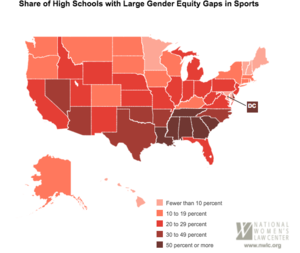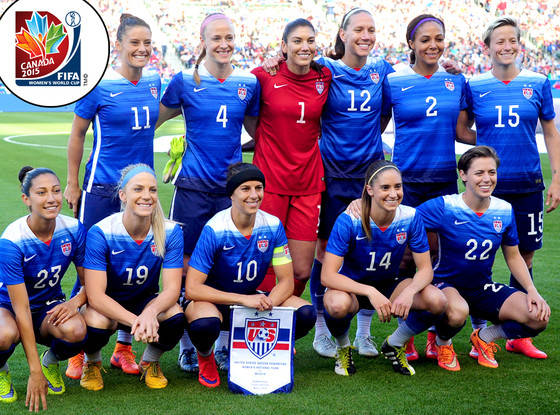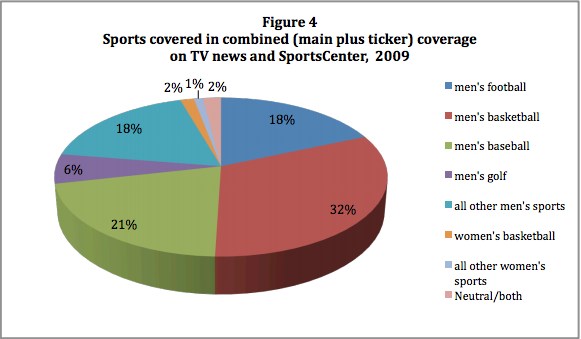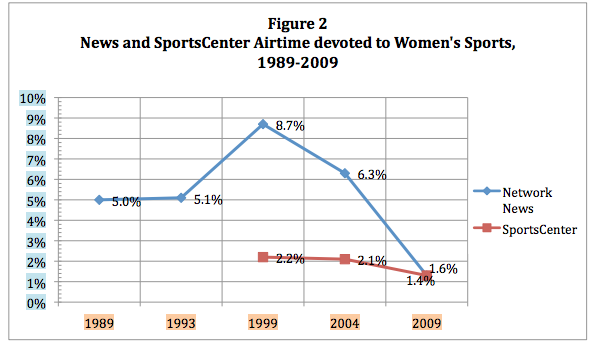Gender Discrimination In Sports
Gender Discrimination occurs when prejudice influences the treatment of a gender. Gender Discrimination is prevalent in many athletics, from high school to professional athletics. This can be due to prejudices about the physicality differences between males and females. This discrimination can be shown through unequal wage, unequal viewership, and unequal opportunities between the difference sexes.
High School Sports
Opportunities
According to the article "High school sports: Girls losing gender equity game" [1], in 2009-2010 for every 100 boys 53 athletic opportunities were given, whereas for every 100 girls 41 opportunities were given.
Title IX
Title IX was an act made effective in 1972 that set out to ensure that no student be discriminated against based on sex in regards to educational programs or activities. According to The Atlantic [2], Title IX worked as it increased the amount of female activity in college sports by five times as much as it was in 1972. Title IX also worked in high schools, as now in high school sports participation for girls is two for every five.
College and University Sports
Coaching
According to Forbes Magazine [3], the gender wage gap for coaches is extremely high. At Duke University, the men's basketball coach makes almost $10 million annually, whereas the women's basketball coach makes a little over $700,000.
NCAA Prolonging Women's Basketball Players From Joining the WNBA
According to Forbes Magazine [4], the NCAA supports a rule that allows men's basketball players to join the NBA after their first year of college, whereas women must wait to join the WNBA four years after they graduate from high school. This means that the female basketball plays must financially support themselves through three more year of college than their male counterparts would have to. If a player cannot afford to support themselves financially through college, this could result in less opportunities for college female basketball players to become professional.
Professional Sports
Wage Gap
Soccer
According to Forbes Magazine [5] , the U.S. Women's National Team earned $2 million for their 2015 Women's World Cup Soccer victory. This match was the most watched soccer match in U.S. history. Forbes compares this to the U.S. mens team coming in 11th in 2014, where they collected $9 million dollars.
The women's team earned a little over 20% of what the mens team earned, even though they came in first, compared to the mens 11th placing. The earnings of both teams is not reflected of the viewership as, according to Forbes, the women's final game was the most watched games in U.S. history.
Basketball
According to Forbes Magazine[6], the minimum salary in the WNBA in 2015 was $38,000 and the maximum salary was $109,500. The NBA minimum salary in 2015 was $525,093 and the maximum was $16.407 million. The women's highest annual salary for professional basketball was a little of 1/5 of the men's minimum salary for the same year.
Viewership
Generally, women's sports get less coverage and less viewership that men's sports. There is no single, clear reason as the why women's sports viewership is lower, however there are multiple factors that could play a role.
According to The Atlantic [7], a reason the viewership is lower is that the production quality of professional women's sports is not as high as their male counterparts. The lower quality production results in the game appearing less exciting, therefore getting less viewership.
Women's teams sports appear to be less popular than women's individual sports. According to The Atlantic [8] this is due to the differing physical abilities and strength between men and women. The Atlantic article claims that the physical differences between men and women is more obvious in team sports compared to individual sports where women can show physical strengths that they are stronger in compared to men (for example, flexibility in figure skating).
According to research report "Gender In Televised Sports: News and Highlight Shows, 1989‐2009" [9], women's sports get less airtime than men's.
The lower coverage of women's sports results in less viewership and a smaller fanbase. The lesser viewership ultimately leads to less advertiser interest and less airtime.
Multiple factors influence the lesser viewership of women's sports, compared to men's. Since women's athletics gets less viewership, they also get less advertisement and sponsors, which results in a lesser pay and lower production value. Overall, these factors create a cycle that keeps women's sports viewership and pay lower than their male counterparts.
References
- ↑ Wadley, J. (2012) "High school sports: Girls losing gender equity game". University of Michigan News. Retrieved 7 April 2017
- ↑ Wong, A. (2015) "Where Girls Are Missing Out on High-School Sports". The Atlantic. Retrieved 7 April 2017
- ↑ Edelman, M. (2014) "The Truth About Gender Equity In College Sports And The College Athletes' Rights Movement". Forbes Magazine. Retrieved 6 April 2017.
- ↑ Edelman, M. (2014) "The Truth About Gender Equity In College Sports And The College Athletes' Rights Movement". Forbes Magazine. Retrieved 6 April 2017.
- ↑ Brennon, A. (2016) "Which Sports Have The Largest And Smallest Pay Gaps?". Forbes Magazine. Retrieved 6 April 2017.
- ↑ Brennon, A. (2016) "Which Sports Have The Largest And Smallest Pay Gaps?". Forbes Magazine. Retrieved 6 April 2017.
- ↑ Bodenner, C. (2015) "Why Aren't Women's Sports as Big as Men's? Your Thoughts". The Atlantic. Retrieved 7 April 2017
- ↑ Bodenner, C. (2015) "Why Aren't Women's Sports as Big as Men's? Your Thoughts". The Atlantic. Retrieved 7 April 2017
- ↑ Cooky, C., Hextrum, R., Messner, M.A. (2010) "Gender In Televised Sports: News and Highlight Shows, 1989‐2009". University of Southern California. Retrieved 7 April 2017.
Rachel Nishi




